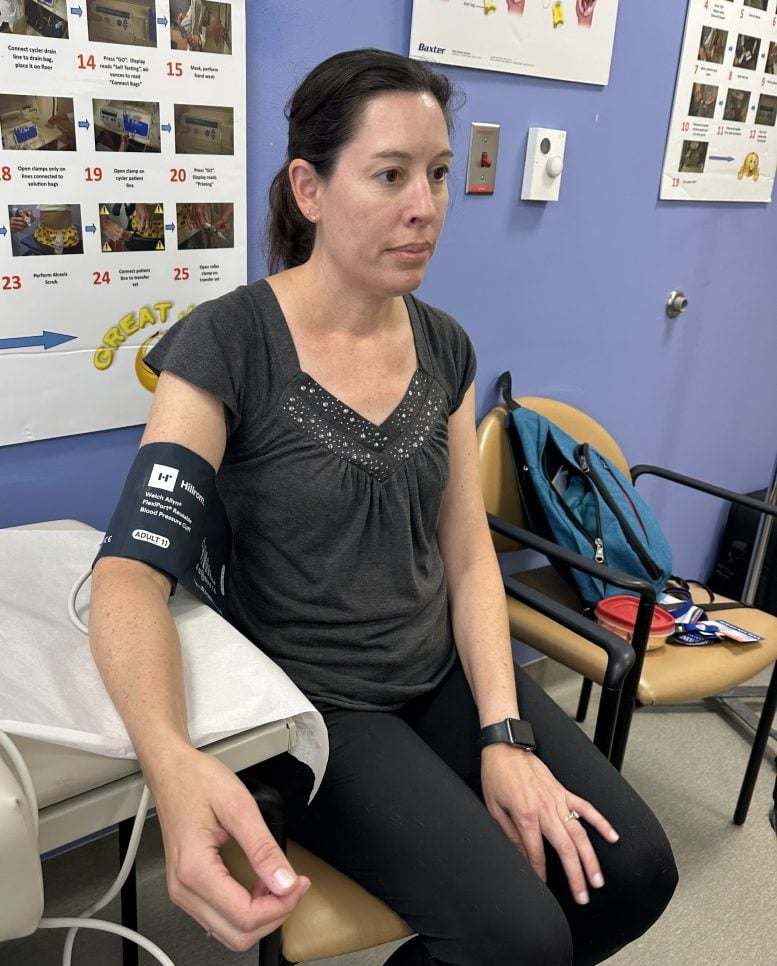

Investigators suggest that not following arm support guidelines during blood pressure screening could have a substantial clinical impact.
A study conducted by researchers at Johns Hopkins Medicine found that common methods of positioning a patient’s arm during blood pressure (BP) screenings can significantly overestimate the readings, potentially leading to misdiagnosis of hypertension.
In a report on the study, which was recently published in JAMA Internal Medicine, investigators examined the effects of three different arm positions: an arm supported on a desk, arm supported on a lap, and an unsupported arm hanging at the patient’s side. Researchers found that lap support overestimated systolic pressure (the top number in a BP reading) by nearly 4 mmHg, and an unsupported arm hanging at the side overestimated systolic pressure by nearly 7 mmHg.
The findings confirm that arm position makes a “huge difference” when it comes to an accurate blood pressure measurement, says Tammy Brady, M.D., Ph.D., vice chair for clinical research in the Department of Pediatrics at the Johns Hopkins University School of Medicine, medical director of the pediatric hypertension program at Johns Hopkins Children’s Center, deputy director of the Welch Center for Prevention, Epidemiology, and Clinical Research and senior author of the study. And they underscore the importance of adhering to clinical guidelines calling for firm support on a desk or other surface when measuring blood pressure, the investigators add.
Blood Pressure and Hypertension Risks
According to the American Heart Association, nearly half of U.S. adults have elevated blood pressure, a diagnosis made when the measured force of blood flowing through blood vessels is higher than what is generally considered normal, on average 120/80. Untreated, high blood pressure increases the risk of stroke, heart attack, and other serious cardiovascular conditions.
Because hypertension may cause minimal or no symptoms, early and frequent screening during routine checkups is considered the cornerstone of hypertension management. In most cases, lifestyle changes such as weight loss, healthy diets, and exercise, as well as therapy with any of a variety of medications, can keep BP under control.

The latest clinical practice guidelines from the American Heart Association emphasize several key steps for an accurate measurement — including appropriate cuff size, back support, feet flat on the floor with legs uncrossed, and an appropriate arm position, in which the middle of an adjustable BP cuff is positioned at mid-heart level on an arm supported on a desk or table.
Study Design and Findings
Despite these recommendations, the researchers say BP is too often measured with patients seated on an exam table without any, or inadequate, arm support. In some cases, a clinician holds the arm, or the patient holds an arm in their lap. In the new Johns Hopkins study, the researchers recruited 133 adult participants (78% Black, 52% female) between Aug. 9, 2022, and June 1, 2023.
Study participants, who ranged from age 18 to 80, were sorted at random into one of six possible groups that differed by order of the three seated arm positions. Measurements were taken during a single visit between 9 a.m. and 6 p.m. Before BP measures were taken, all participants first emptied their bladders and then walked for two minutes to mimic a typical clinical scenario in which people walk into a clinic or office before screening takes place.
They then underwent a five-minute, seated rest period with their backs and feet supported. Each person, wearing an upper arm BP cuff selected and sized based on their upper arm size, had three sets of triplicate measurements taken with a digital blood pressure device 30 seconds apart.
Upon completion of each set of three measurements, the cuff was removed, participants walked for two minutes and rested for five minutes. In the same visit, they then underwent a fourth set of triplicate measurements with their arm supported on a desk, a set used to account for well-known variations in BP readings. All of the measurements were conducted in a quiet and private space, and participants were asked not to talk to researchers or use their phones during the screening.
Overestimation with Common Arm Positions
Researchers found that BP measurements obtained with arm positions frequently used in clinical practice — an arm on the lap or unsupported at the side — were markedly higher than those obtained when the arm was supported on a desk, the standard, recommended arm position.
Supporting the arm on the lap overestimated systolic BP — the top number of a reading, or the force of blood flow when pumped out of the heart, by 3.9 mmHg and diastolic blood pressure — the bottom number, or the pressure in the arteries when the heart rests between beats, by 4.0 mmHg. An unsupported arm at the side overestimated systolic by 6.5 mmHg and diastolic by 4.4 mmHg.
“If you are consistently measuring blood pressure with an unsupported arm, and that gives you an overestimated BP of 6.5 mmHg, that’s a potential difference between a systolic BP of 123 and 130, or 133 and 140 — which is considered stage 2 hypertension,” says Sherry Liu, M.H.S., an epidemiology research coordinator at the Welch Center for Prevention, Epidemiology, and Clinical Research, Department of Epidemiology, at Johns Hopkins Bloomberg School of Public Health and study author.
Investigators caution that their study results may only apply during screenings with automated BP devices, and may not apply to readings done with other BP devices.
However, Brady says, the findings suggest that clinicians need to pay better attention to best practice guidelines, and that patients “must advocate for themselves in the clinical setting and when measuring their BP at home.”
Reference: “Arm Position and Blood Pressure Readings: The ARMS Crossover Randomized Clinical Trial” by Hairong Liu, Di Zhao, Ahmed Sabit, Chathurangi H. Pathiravasan, Junichi Ishigami, Jeanne Charleston, Edgar R. Miller, Kunihiro Matsushita, Lawrence J. Appel and Tammy M. Brady, 7 October 2024, JAMA Internal Medicine.
DOI: 10.1001/jamainternmed.2024.5213
Along with Brady and Liu, authors from Johns Hopkins are Di Zhao, Ahmed Sabit, Chathurangi Pathiravasan, Junichi Ishigami, Jeanne Charleston, Edgar Miller III, Kunihiro Matsushita, and Lawrence Appel.
This study was supported by Resolve to Save Lives, which is funded by Bloomberg Philanthropies, the Bill and Melinda Gates Foundation and Gates Philanthropy Partners, which is funded with support from the Chan Zuckerberg Foundation.